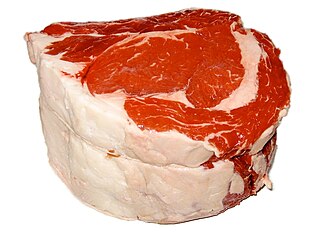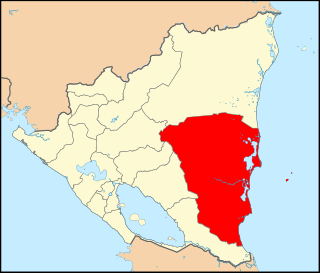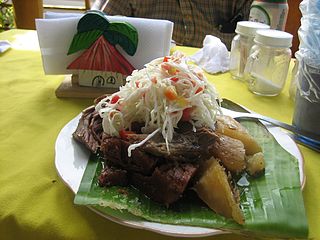Carne pinchada (translation: stabbed meat) is a Nicaraguan dish consisting of meat (such as beef or chicken) marinated in an alcohol sauce, using beer (Tona or Victoria), wine, etc. It is usually served on a stick.
Carne pinchada (translation: stabbed meat) is a Nicaraguan dish consisting of meat (such as beef or chicken) marinated in an alcohol sauce, using beer (Tona or Victoria), wine, etc. It is usually served on a stick.

Beef is the culinary name for meat from cattle. Beef can be prepared in various ways; cuts are often used for steak, which can be cooked to varying degrees of doneness, while trimmings are often ground or minced, as found in most hamburgers. Beef contains protein, iron, and vitamin B12. Along with other kinds of red meat, high consumption is associated with an increased risk of colorectal cancer and coronary heart disease, especially when processed. Beef has a high environmental impact, being a primary driver of deforestation with the highest greenhouse gas emissions of any agricultural product.

A tamale, in Spanish tamal, is a traditional Mesoamerican dish made of masa, a dough made from nixtamalized corn, which is steamed in a corn husk or banana leaves. The wrapping can either be discarded prior to eating or used as a plate. Tamales can be filled with meats, cheeses, fruits, vegetables, herbs, chilies, or any preparation according to taste, and both the filling and the cooking liquid may be seasoned.

Salsa criolla is a type of sauce or relish found in Latin American cuisine, composed of finely chopped sliced onions, vinegar, tomatoes, garlic, chili peppers, bell peppers, olive oil, salt, pepper and fresh herbs like parsley or cilantro. Salsa criolla is often associated with Peruvian cuisine, but also found in Cuban, Puerto Rican, Nicaraguan, Uruguayan, and Argentinian cuisine.

Latin American cuisine is the typical foods, beverages, and cooking styles common to many of the countries and cultures in Latin America. Latin America is a highly racially, ethnically, and geographically diverse with varying cuisines. Some items typical of Latin American cuisine include maize-based dishes arepas, empanadas, pupusas, tacos, tamales, tortillas and various salsas and other condiments. Sofrito, a culinary term that originally referred to a specific combination of sautéed or braised aromatics, exists in Latin American cuisine. It refers to a sauce of tomatoes, roasted bell peppers, garlic, onions and herbs. Rice, corn, pasta, bread, plantain, potato, yucca, and beans are also staples in Latin American cuisine.

The South Caribbean Coast Autonomous Region is one of two autonomous regions in Nicaragua. It was created along with the North Caribbean Coast Autonomous Region by the Autonomy Statute of 7 September 1987 through a division of the former Zelaya Department. It covers an area of 27,260 km2 (10,530 sq mi) and has a population of 420,935. The capital is Bluefields. Bordering the Caribbean Sea, it contains part of the region known as Mosquitia.

Pabellón criollo is a traditional Venezuelan dish that is considered the national dish. It mixes elements from the three different cultures that intermixed during Spanish colonials times: Native Americans, Spanish and Africans. The name is a synonym to flag, since it was one of the main original associations. It is a plate of rice, shredded beef in stew and stewed black beans.

Nicaraguan cuisine includes a mixture of Mesoamerican, Chibcha, Spanish, Caribbean, and African cuisine. Despite the blending and incorporation of pre-Columbian, Spanish and African influences, traditional cuisine differs from the western half of Nicaragua to the eastern half. Western Nicaraguan cuisine revolves around the Mesoamerican diet of the Chorotega and Nicarao people such as maize, tomatoes, avocados, turkey, squash, beans, chili, and chocolate, in addition to potatoes which were cultivated by the Chibcha people originating from South America and introduced meats like pork and chicken. Eastern Nicaraguan cuisine consists mostly of seafood and coconut.

Vaho or baho is a mix of meat, green plantains and yuca cooked in banana leaves. It is a traditional Nicaraguan dish originated from the mix of cultures between the indigenous, mestizos and Afro-Nicaraguans of the country.

A nacatamal is a traditional Nicaraguan dish similar to the tamal and to the hallaca. Nacatamales originated from the Nicarao tribes who inhabited western Nicaragua, its name originates from the Nawat language and translates to 'meat tamale'. During pre-columbian times, the Nicarao were using hunted meats like deer and turkey with ingredients such as tomatoes, achiote and herbs to season and increase the nacatamal's flavor before being wrapped in corn husks and steamed. After Spanish conquest, nacatamales were made with introduced meats like pork. They also evolved to include flavorful ingredients like onions and banana leaves replaced corn husks. The nacatamal is perhaps the most produced within traditional Nicaraguan cuisine and is typically eaten on the weekend, for dinner, or for breakfast; it is usually eaten together with white bread and a caffeinated drink like black coffee, Coca-Cola or Pepsi. It is common to enjoy nacatamales (plural) during special occasions and to invite extended family and neighbors to partake.

Dried meat is a feature of many cuisines around the world. Examples include:

Rice and beans, or beans and rice, is a category of dishes from many cultures around the world, whereby the staple foods of rice and beans are combined in some manner. The grain and legume combination provides several important nutrients and many calories, and both foods are widely available. The beans are usually seasoned, while the rice may be plain or seasoned. The two components may be mixed together, separated on the plate, or served separately.

A güirila is a sweet type of tortilla made from young white maize. They are usually eaten with crema and cuajada, a type of salty Nicaraguan crumbled white cheese.

Ropa vieja is a dish with regional variations in Latin America, the Philippines, and Spain. It normally includes some form of stewed beef and tomatoes with a sofrito base. Originating in Spain, it is known today as one of the national dishes of Cuba. The name ropa vieja probably originates from the fact that it was often prepared using food left over from other meals.

The Nicaraguan Football Federation is the official governing body of association football in Nicaragua.

Tocino is bacon in Spanish, typically made from the pork belly and often formed into cubes in Spain. In Caribbean countries, such as Puerto Rico and Cuba, tocino is made from pork fatback and is neither cured nor smoked but simply fried until very crunchy; it is then added to recipes, much like the way lardons are used in French cuisine. In the Philippines, tocino refers to sweetened and cured pork belly.

Arroz a la valenciana or Valencian rice is a name for a multitude of rice dishes from diverse cuisines of the world, which originate from the rice-cooking tradition of the Valencian Community, in eastern Spain.

Football is the second most popular sport in Nicaragua after baseball.

In English, fritanga refers to a restaurant that makes home-style Nicaraguan foods. The staple foods at a fritanga may include gallo pinto, arroz blanco, carne asada, tajada frita, platano frito, maduros, yuca, queso frito, tortilla and cabbage salad. Fritangas also carry daily specials such as salpicón, carne desmenuzada, and enchiladas, as well as speciality drinks and desserts/pastries. Fritangas have a cafeteria (comideria) style of ordering and the food can be taken out or consumed at the establishment.
Miss World Nicaragua is a beauty pageant in Nicaragua that selects the country's representatives to the Miss World, Mister World and Miss Earth ones of the Big Four international beauty pageants.

Nicaragua requires its residents to register their motor vehicles and display vehicle registration plates. Current plates are North American standard 6 × 12 inches. In the background of the plate, it is represented the map of Nicaragua. The display of letters and numbers is one or two letters that identifies the region and a group of serial numbers.